FORCE AND PRESSURE for Class 8 SCIENCE
INTRODUCTION
Hamare chapter ka name hai force and pressure, iss chapter mein hum force aur pressure dono ke baare mein aur inke relation ke baare mein padhenge. Yahan hum janege force kya hota hai, yeh kaise apply hota hai, force ke effects kya hai, iske types kya hai, etc. Yaha hum contact aur non-contact force ke types jaise gravitational force, frictional force, muscular force, electrostatic force, etc ke baare mein padhenge. Fir hum pressure ke baare mein bhi janege, hum dekhenge ki liquids aur gases kaise pressure exert karte hai aur thoda atmospheric pressure ke baare mein bhi janege.
Force - A Push or a Pull
Jab bhi koi object doosre object ko pull ya push karta hai usko hum force kehte hai.
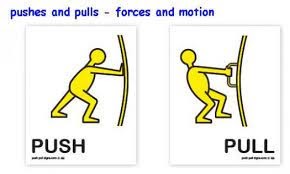
Jab bhi hum koi action jaise picking, opening, shutting, kicking, hitting, lifting, pushing, pulling, etc. perform karte hai toh object move karte hai, aur jab yeh object move karte hai toh push ya pull karte hai. Eg- Jab hum koi door shut karte hai toh hum usko push karte hai, agar hum koi drawer open karte hai toh usko pull karte hai. Iss tarah jab bhi hum koi action perform karke kisi object ko move karte hai toh hum us object par force exert karte hai.
Forces are due to an Interaction
Force arise karne ke liye atleast do objects ke beech mein interaction hona jaruri hota hai. Jab tak do objects ke beech mein interaction nahi hota tab tak force apply nahi hota aur object stationary rehta hai.Eg- Agar ek man stationary car ke peeche khada hai aur unke beech mein koi interaction nahi hai toh car move nahi karegi.
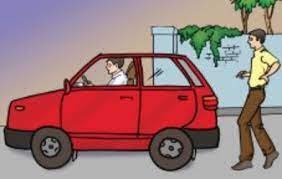
Agar ek man car ko push karta hai toh car uss direction mein move karti hai jis direction mein force apply kiya jata hai.

Niche figure mein hum dekh sakte hai man aur cow ek doosre ko pulll kar rahe hai aur ek doosre par force exert kar rahe hai.
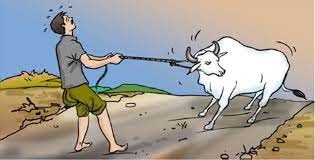
Exploring Forces
Force ka magnitude aur direction dono hota hai. Force ki strength ko hum magnitude mein express karte hai lekin iske saath force ki direction mention karna bhi important hota hai kyonki direction change karne se force ka effect change hota hai.
Ab hum jante hai ki direction change karne se force ka effect kaise change hota hai.
A Force Can Change the State Of Motion
Force kisi object ka state of motion change kar sakti hai. Eg- Agar koi body motion mein hai toh force ki wajah se woh rest par aa sakti hai, agar koi body rest par hai toh force ki wajah se woh motion mein aa sakti hai aur force kisi body ki speed mein bhi change la sakti hai. Ab kuchh examples ki help se hum inn baato ko samjhenge.Force ki wajah se speed ke sath sath motion ki direction bhi change hoti hai aur inn dono hi changes ko hum change in state of motion mein consider karte hai.
Sometimes aisa hota hai ki force apply karne se bhi object move nahi karta toh woh force object par kya effect cause karti hai?
Iske baare mein hum next topic mein padhenge.
Force can Change the Shape of an Object
Abhi hamne padha ki kisi object par jab force lagta hai toh uska state of motion change ho jata hai lekin kabhi-kabhi aisa bhi hota hai ki force apply karne ki wajah se state toh change nahi hoti par object ki shape change ho jati hai. Isko samajhne ke liye hum kuchh examples dekhenge.
Force different types ke hote hai, ab hum different types of forces ke baare mein padhenge.
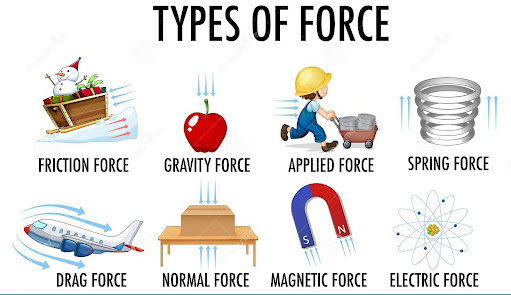
Contact Forces
Aise forces jinko apply karne ke liye hamein touch ya contact banana pade usko contact forces kehte hai. Eg- Muscular force, frictional force.Muscular Force
Muscles ke action ki wajah se kisi object par jo force lagta hai usko muscular force kehte hai. Hum daily life mein muscular force ke bahut examples dekh sakte hai.Friction
Friction is defined as the resistance offered by the surfaces that are in contact when they move past each other.Ab hum iske kuchh examples dekhte hai.
Non- contact Forces
Aise forces jinko contact ki jarurat nahi hoti aur yeh bina touch ke hi apna influence kisi object par show karte hai. Eg- Magnetic force, electrostatic force, gravitational force, etc.
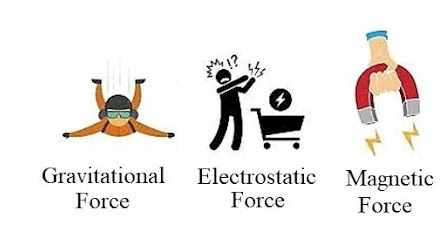
Magnetic Force
Electrically charged moving particles aur magnet ke poles ke beech mein jo attractive aur repulsive force act karti hai usko magnetic force kehte hai.Magnet ke do poles hote hai- south pole aur north pole. Jab bhi hum do magnets ke same poles ko ek doosre ke paas laate hai toh woh repel karte hai aur agar iske do opposite poles ko paas laate hai toh yeh dono poles attract karte hai. Hum magnet ko kisi metal ke paas lekar jate hai toh woh metal ki taraf attract hota hai. Magnetic force ko experience karne ke liye hamein objects ko contact mein laane ki jarurat bhi nahi hoti.
Electrostatic Force
Jab ek charged body doosri charged ya uncharged body par force exert karti hai toh usko hum electrostatic force kehte hai.Ab hum ek activity ki help se dekhenge ki electrostatic force kaise work karta hai.
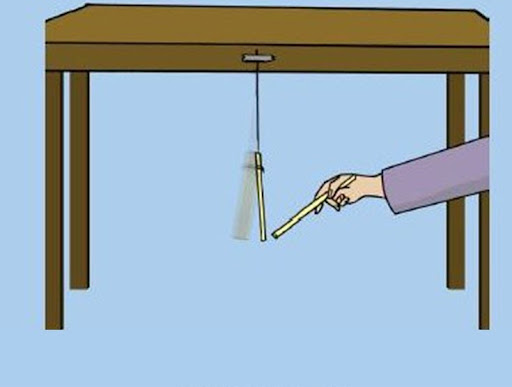
Gravitational Force
Iss universe mein har ek object doosre object par force exert karta hai, iss force ko hi hum gravitational force ya force of gravity kehte hai.Gravitational force universal force of attraction hota hai jo saare matter par apply hota hai. Yeh aisa force hota hai jo do objects ko mass ke sath attract karta hai.
Gravity ke force ki wajah se hi jo bhi object fall karta hai woh hamesha earth ki taraf hi jata hai. Eg- Agar hamare hand se pen slip hota hai toh woh ground ki taraf hi fall karta hai, agar hamare hand mein koi coin hai aur hum usko release karte hai toh woh bhi ground ki taraf hi fall karega, Jaise hi hum tap open karte hai water ground ki taraf flow karta hai, rivers mein water bhi gravitational force ki wajah se hi flow karta hai. Daily life mein hum aise bahut saare examples dekh sakte hai.
Pressure
Ab tak hamne force ke baare mein padha ab hum janege ki pressure kya hota hai aur force aur pressure mein kya relation hai.
Ek surface ke per unit area par jo force act karta hai usko hum pressure kehte hai.

Pressure ki SI unit pascal hoti hai, isko hum (Pa) se denote karte hai.
Force aur pressure ek doosre par dependent hote hai.

Pressure Exerted by Liquids and Gases
Liquid aur gases dono hi container ke bottom ke sath-sath sabhi directions mein pressure exert karte hai.
Eg- Agar hum ek balloon ko inflate karke uska mouth seal karde aur uske sides mein holes karde toh kuchh der baad kya hoga?
Uss balloon ki saari air nikal jayegi kyonki gases sabhi directions mein pressure exert karti hai.
Agar hum same experiment water bottle mein water fill karke karenge toh bottle mein se bhi saara water leak kar jayega kyonki water ek liquid hai aur yeh bhi sabhi directions mein pressure exert karta hai.
Atmospheric Pressure
Ab atmospheric pressure ko janne ke liye sabse pehle hamara yeh janna jaruri hai ki atmosphere kya hota hai.Atmosphere ek gases ki layer ka ek envelop hai jo earth ko surround karta hai. Atmosphere mein jo air present hoti hai usko hum atmospheric air kehte hai. Yeh air earth ke surface ke upar bhi bahut kilometres tak extend karti hai aur yeh air jo pressure exert karti hai usko hum atmospheric pressure kehte hai.
Jaise hum earth ke surface ki taraf move karte hai atmospheric pressure increase hota jata hai.
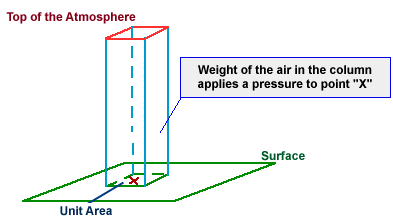
Atmosphere ke large area ki wajah se hamare upar bahut jyada atmospheric pressure lagta hai lekin hum iska koi effect experience nahi kar paate kyonki hamari body ke andar ka air pressure bahar ke atmospheric pressure ke equal hota hai aur yeh dono ek doosre ko cancel out kar dete hai. Isliye hamari body atmospheric pressure ke sath balance create kar pati hai.
Sometimes jab hum higher altitudes par jaate hai waha atmospheric pressure less hota hai isliye hamein nose bleeding ho sakti hai. Aisa isliye hota hai kyonki uss time par hamari body ka blood pressure atmospheric pressure se jyada ho jata hai.
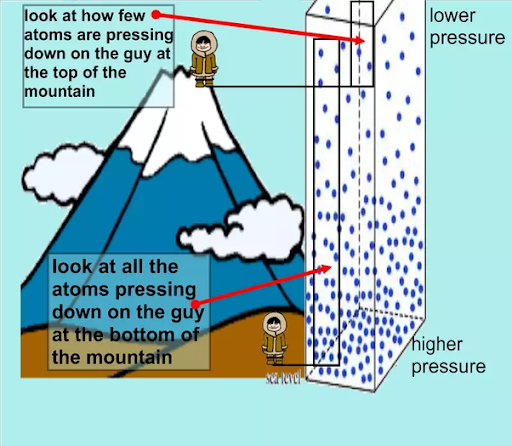
POINT 1
Atmospheric pressure: Atmospheric pressure is defined as the force per unit area exerted against a surface by the weight of the air above that surface.
Contact force: Contact force is a force that is applied by objects in contact with each other.
Electrostatic force: The electrostatic force is an attractive and repulsive force between particles are caused due to their electric charges.
Force: Push or pull of an object is considered a force.
Friction: Friction is defined as the resistance offered by the surfaces that are in contact when they move past each other.
Gravitational force: The gravitational force is a force that attracts any two objects with mass.
Magnetic force: Magnetic Force can be defined as the attractive or repulsive force that is exerted between the poles of a magnet and electrically charged moving particles.
Muscular force: Muscular force can be defined as the force that is created through the use of muscles.
Non- contact force: A non-contact force is a force which acts on an object without coming physically in contact with it.
Pressure: Pressure is the amount of force applied at right angles to the surface of an object per unit area.
SUMMARY
1.Force could be a push or a pull.
2.A force arises due to the interaction between two objects.
3.Force has magnitude as well as direction.
4.A change in the speed of an object or the direction of its motion or both implies a change in its state of motion.
5.Force acting on an object may cause a change in its state of motion or a change in its shape.
6.A force can act on an object with or without being in contact with it.
7.Force per unit area is called pressure.
8.Liquids and gases exert pressure on the walls of their containers.
9.The pressure exerted by air around us is known as atmospheric pressure.